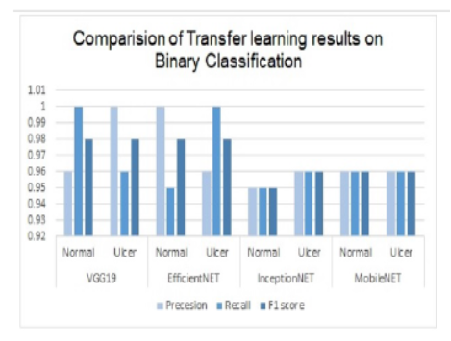


Indian Journal of Science and Technology
Year: 2024, Volume: 17, Issue: 7, Pages: 651-659
Original Article
Rinkal Shah1*, Jyoti Pareek2
1Research Scholar, Department of Computer Science, Gujarat University, Ahmedabad, Gujarat, India
2Professor and Head, Department of Computer Science, Gujarat University, Ahmedabad, Gujarat, India
*Corresponding Author
Email: [email protected]
Received Date:31 October 2023, Accepted Date:22 January 2024, Published Date:14 February 2024
Objectives: To develop a deep learning method using camera images that can effectively detect the preliminary phase of oral cancer, which has a high rate of morbidity and mortality and is a significant public health concern. If left untreated, it can result in severe deformities and negatively affect the patient's quality of life, both physically and mentally. Early detection is crucial owing to the rapid spread of the disease, where biopsy is the only option left. Therefore, it is essential to identify malignancies swiftly to prevent disease progression non-invasively. Methods: Three different scenarios are used in this study to analyze samples: CNN architecture, stratified K-fold validation, and transfer learning. For automated disease identification on binary datasets (normal vs. ulcer) and multiclass datasets (normal vs. ulcer vs. Leukoplakia), camera images are pre-processed with data augmentation. As a feature extractor in the model, transfer learning is used with pre-defined networks such as VGG19, InceptionNET, EfficientNET, and MobileNET weights. Findings: Using the proposed CNN architecture, the F1 score for image classification was 78% and 74% for photos showing hygienic mouths or ulcers, and 83%, 87%, and 84% for images showing normal mouths, ulcers, and leukoplakia. Using stratified 3-fold validation, the results were improved to 97%, and an EfficientNET achieves the highest results in a binary F1 score of 98% and a classification with multiple classes F1 scores of 98%, 87%, and 91%, respectively. Novelty: Previous studies have mostly concentrated on differentiating oral potentially malignant diseases (OPMD) from oral squamous cell carcinoma (OSCC) or on discriminating between cancerous and non-cancerous tissues. The objective is to diagnose patients with non-invasive procedures to classify ulcers, healthy mouths, or precancerous type "Leukoplakia" without requiring them to visit a doctor.
Keywords: CNN, Transfer Learning, Oral Cancer, Ulcer, Leukoplakia, Stratified K-fold validation
© 2024 Shah & Pareek. This is an open-access article distributed under the terms of the Creative Commons Attribution License, which permits unrestricted use, distribution, and reproduction in any medium, provided the original author and source are credited. Published By Indian Society for Education and Environment (iSee)
Subscribe now for latest articles and news.